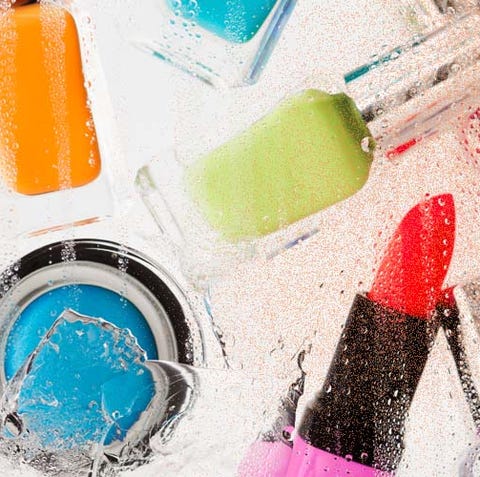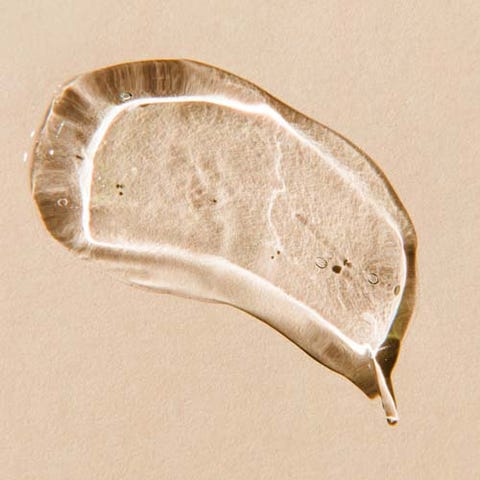Products You May Like
When Nancy Gagnon, a formulator at the Designer Beauty Lab in Santa Ana, California, ventured out into a summer heat wave wearing a full face of makeup, the final look wasn’t quite what she was going for: “Half of my brows melted off, leaving me looking like some character from a sci-fi movie,” she recalls.
Carrying out real-world tests of cosmetics from competitor brands like this is a key part of product research for Gagnon. It’s not the only time she has come across makeup that is no match for the hot spells which regularly scorch her city—and she’s not alone.
As extreme climate events sweep the globe, melting makeup, evaporating eau de cologne, and stylers that liquefy in sunlight have become commonplace. Many of our products just aren’t built for the record temperatures we’ve seen this summer and last summer, this winter, and the winter before. But with sweltering heat forecasts to make frequent future appearances, how will brands adapt?
At Antrim Cosmetic Solutions in Toronto—a city which broke its own heat record in June— chemist Anjali Hardikar has first noticed changes in consumer habits.
“People are leaning towards products like sheet masks and hydrating mists which provide moisture and nourishment, along with cooling relief to the skin in heat,” she says. “Paper soaps and shampoo or soap bars are also well-accepted as they are not affected by heat.” And while these sturdier products should see us through the heatwaves to come, other staples are a little more delicate. “Creams can break at higher temperatures, either because the water phase is lacking a water-binding agent like a polymer, or a suitable hydrocolloid, like xanthan gum,” Hardikar explains. “Or, the emulsifier type or amount is not enough to keep the cream together.”
Thanks to its complex blends of oils and UV filters, sunscreen, the ultimate hot weather staple, is extremely heat-sensitive. And even when our lotions and potions seem to be holding up, the actives inside them may not be. Naturally volatile essential oils can vaporize and oxidize easily, reducing beauty benefits and leaving fragrances unrecognizable. Hyaluronic acid starts to break down at around 99F, while just a day in 104-degree heat—11 degrees below the record-breaking temperatures that hit the Pacific northwest this summer—will dramatically degrade some peptides.
And if it’s so hot it seems like even your lipstick is sweating, it probably is: high temperatures often cause syneresis, where the liquid part of a product gets squeezed out, leaving sweat-like droplets on the surface.
So why are our products so susceptible to the weather? “Big corporations already test their products at elevated temperatures,” says Andreas Nievergelt, a pharmaceutical scientist and formulator. The problem is, in countries which aren’t usually that hot, those stability tests still assume a product will be stored at a room temperature of 68-75F. This is right—most of the time. But recent weather has made it seem less like the norm.
But in some places, extreme temperatures are the new normal. Gagnon, whose company often manufactures for overseas brands, already has to take this into account. “We’ve conducted projects with extreme climates or unique climate factors since day one,” she says, “It’s part of our basic R&D.”
Formulators who create products for extreme weather often use extreme testing methods to ensure they go the distance: from incubators to simulate 122-degree heat, to hundred-mile car trips with products rattling around in the trunk. Their ingredients can differ too, often including extra, more powerful emulsifiers to help resist heat.
But manufacturers in regions which are new to extremes might be reluctant to change their formulas just yet: “If one adjusts a foundation to withstand or work at higher temperatures it will under-perform at lower, normal ones,” explains Andreas, adding, “These will still be the majority of the time.”
Luckily, some products are already adapted to extreme heat. “If I’m going to be in the high heat of the day, I’m going to use the longer wear formulas,” says Gagnon, who frequently works on this product type. “Some formulas in this same category, you could go swimming with them on.”
When it comes to moisturizer, gel creams are ideal, says Anjali, “they are very light and easily absorbed to provide a non-greasy skin feel in hot, humid climates.”
For your strands, conditioners formulated for tropical climes, like Brazil and the Dominican Republic, can make heatwave haircare a little easier.
But climate change doesn’t just affect what’s inside the jar; containers might need to adapt too. “The main problem is high temperatures and temperature changes,” Matteo Mariani, a packaging designer at the Milan-based MAIS Project tells me. “If the packaging is not designed for this, these two situations can seriously damage the integrity of the product. With plastics, “heat can change the stiffness, it can create cracks on the surface, it can change the color or the shape.”
In turn, heat-damaged packaging changes the amount of air inside the product, setting off all kinds of new chemical storms. “The solution is a sealed container,” says Andreas, though the extra cost might put off companies who don’t already seal.
For brands who do, ‘sealing’ can happen at a microscopic level too: encapsulating fragile ingredients protects them from higher temperatures in the packaging, says Anjali. “Customers get the full benefit of the actives when the product is applied to the skin.”
Meanwhile, climate change isn’t just making us hotter. The rise in global temperature produces all kinds of erratic weather. This year has seen devastating hurricanes, cyclones, wildfires, and flooding which climate scientists have quantitatively linked to warming.
Droughts are yet another consequence already impacting the beauty industry, leaving many brands looking to decrease their water footprint, to ease the pressure on freshwater supplies brought low by climate change, pollution, and overuse.
“Being in California, which is having a water crisis, I have fallen in love with multi‐functional products,” Gagnon says. “For instance, I use a 3-in-1, rinse‐free, micellar formula that was designed to not need a sink.” Water-free products like dry shampoos and conditioning bars are becoming more commonplace, too, with some brands opting for face masks in tablet-form, which also prevents their products from drying out in hot weather. And where H2O can’t be eliminated, ingredient manufacturers have come up with a tantalizing solution: algae-based waters. Internally filtered by the algae themselves, the water is usually a marine industry waste product but can be used to replace freshwater in cosmetics.
Still, adapting our products to resist heat and handle water scarcity isn’t enough. Climate change isn’t only affecting our haircare and skincare products, it’s also changing our hair and skin.
Vijay Limaye is an environmental epidemiologist who investigates the health consequences of our rapidly-changing climate. He’s already seen how climate change can tangle with the pollution that causes it, compounding the negative effects.
“Fossil fuels are enormously polluting to the climate and they also degrade air quality,” he says. “Toxic dust can be unleashed into the environment through wildfires and powerful storms, often triggered by climate change.”
That dust frequently contains particle pollutants, which break hair and breach the skin barrier. Extreme heat can push up ozone levels, multiplying free radicals which damage cells and have long been linked to wrinkles, premature greys, and hair loss. Demand for anti-pollution skincare and haircare products is already here, but the effects go much deeper: Vijay’s research also reveals links between climate change, chronic disease and shorter lifespans.
This is why adapting to climate change and building resilience will only take us so far. We have to address the root causes, too.
Like others, the beauty industry relies heavily on fossil fuels. They’re used to source cosmetic ingredients, run plants, transport goods, and also to create a staggering amount of plastic packaging every year. Researching emission-reducing alternatives, the MAIS team discovered several plant-based materials with better technical characteristics than plastic. “We have all the right cards to deal with this overheating,” Matteo says, “but what if we take sustainability into account? The product is there, the technology is there, but the price is different, and when it comes to packaging, it becomes a main driver.”
At least some major players are listening. Beiersdorfer, the makers of Nivea, are the latest to announce renewable packaging, with a pledge to go completely carbon-neutral by 2030.
Still, Andreas cautions against being lulled into a green comfort zone. “Big corporations know how to calculate or green-wash their carbon footprint,” he says. “We have to change our attitude and simply produce, use and waste less.”
Vijay agrees: “It’s great if consumers choose green beauty products over less sustainable options,” he says. “It’s also wise to stop and pause before making purchases to remember that all sorts of elements of the product chain, from manufacturing to water use to transportation, distribution and disposal can have adverse environmental impacts.”
So when can we expect climate-resilient, sustainable beauty products to be de rigueur? Maybe not just yet.
“Mean temperature is ‘only’ rising by a degree or two,” Andreas notes. “Even a few heat peaks in between won’t change that. While local hotspots may develop, and the extreme weather events we saw this year can happen again, I don’t think that the cosmetic industry will do something in the near future. The cost for change is likely higher than living with some losses now and then.”
Gagnon is more optimistic: “You have some incredible professionals in this industry who have big hearts, [who] do what they do to be a change in the industry and remain dynamic, versus making the same, dated formulas for the past 30 years.” But, she admits, “change doesn’t occur overnight.”
This content is created and maintained by a third party, and imported onto this page to help users provide their email addresses. You may be able to find more information about this and similar content at piano.io



